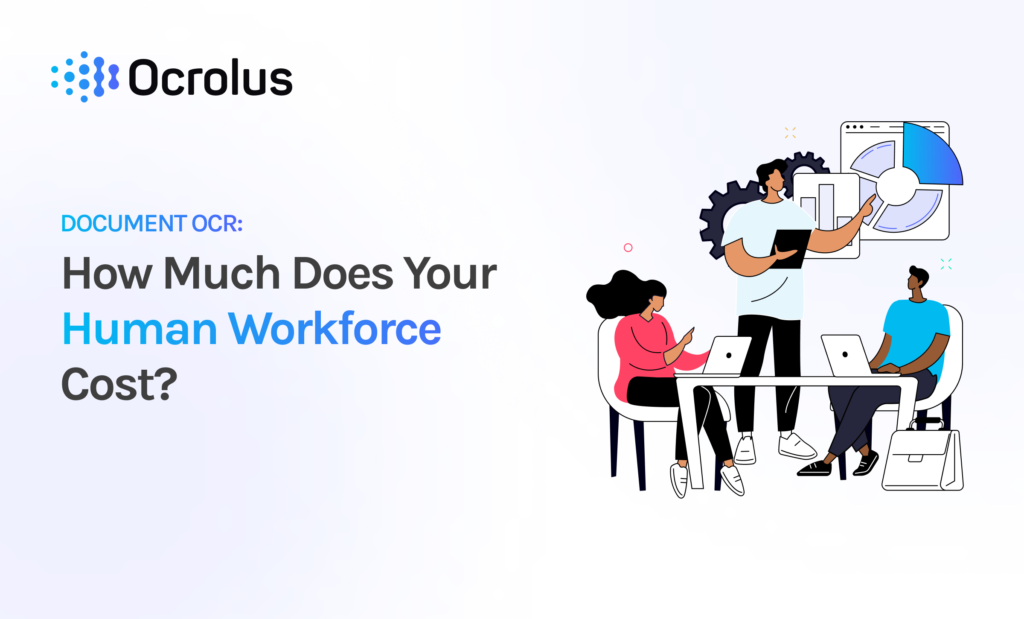This website uses cookies so that we can provide you with the best user experience possible. Cookie information is stored in your browser and performs functions such as recognising you when you return to our website and helping our team to understand which sections of the website you find most interesting and useful.
Document OCR: How Much Does Your Human Workforce Cost?

The cost of a human workforce is, for many organizations, the largest item in their budgets. Human workforce spending can include labor costs such as recruiting, onboarding, training, salaries, and benefits.
For example, employers pay an average of $41.86 per hour worked by a human employee for wages and benefits, according to the U.S. Bureau of Labor Statistics. And when a human worker leaves the organization, employers often pay between three and four times that worker’s salary to recruit and onboard a replacement worker, the Society for Human Resource Management reports. In addition to the hard figures, replacing former employees and training new employees also translate into productivity costs for employers.
In the lending industry, however, the traditional human workforce is transitioning to a combination of automated technology solutions with human workers in the loop. As a result, lenders are experiencing both productivity gains and cost savings.
For example, document optical character recognition (OCR) is a technology that transforms text on a paper document into machine-readable data. Using OCR frees human workers from spending time on tasks such as manual data entry and review, allowing them to focus on more strategic tasks. Automated technology solutions like OCR can make a positive difference in a number of industries, including the lending industry.
What is document OCR?
Document OCR systems use pattern matching or other artificial intelligence techniques to recognize and analyze handwritten or typed characters. With OCR, almost any type of paper or digital document can be transformed into machine-readable text, making it easily searchable and viewable on various devices from various locations. OCR significantly reduces manual errors and minimizes the risk of document fraud.
The evolution of document OCR
In the early 1900s, OCR technology was first developed to transform text into sound for people with visual impairments. Following World War I, scientists developed a machine that used OCR to translate written characters into telegraph code. Over time, that machine evolved into today’s digital credit card and barcode systems. By the 1970s, a commercialized OCR product allowed machines to process text written in different fonts and styles, and in the 1990s, OCR was used to digitize historic newspapers.
When OCR technology was transferred to the cloud in the early 2000s, it became accessible from both desktop and mobile devices. That transformation has allowed OCR to become an increasingly important tool for cutting costs and boosting productivity in the workplace. After years of improvements, the technology now provides more accurate, reliable document scanning than ever before, making it a crucial tool for banks and lenders.
The benefits of document OCR
Document OCR offers a number of benefits for banks and lenders, such as:
Searchability. OCR automatically converts information in documents into structured, indexed data that is easily searchable.
Reliability and accuracy. Humans are prone to error, especially when completing similar tasks repeatedly, such as document analysis and data entry. On the contrary, an OCR solution can maintain reliability and accuracy every time it scans a document.
Faster document workflow process. An OCR solution can reduce the time spent on manual data entry, automatically scanning, cataloging, and analyzing documents, and freeing human workers to focus on more strategic pursuits.
All these benefits make OCR technology a powerful tool for improving current and future business processes. For example, the right OCR solution can eliminate manual data entry, saving time and preserving human resources, and reducing the risk of manual errors.
The best OCR solutions combine machine learning with human validation to get precise data every time. For example, Ocrolus saves time by eliminating manual work and reducing the need for document pre-sorting. Human workers can almost automatically retrieve structured, indexed output for all document types. They can immediately notify borrowers of incorrectly submitted or missing information quickly and immediately see potentially tampered documents.
Cutting costs with document OCR
By automating the process of scanning, cataloging, structuring, and analyzing documents, OCR can boost lenders’ productivity and lower the costs they pay for a human workforce. Rather than paying workers who are prone to fatigue and errors to manually review and analyze documents and input data, employers can handle those tasks automatically with OCR. As a result, human workers can handle the more sophisticated tasks of following up on flagged items, solving problems, interacting with customers about data challenges, and making decisions based on the data.
The most advanced OCR solutions combine the ease of automation with the sophistication of human workers to cut costs across the business and drive more reliable results. For example, Ocrolus goes beyond OCR with intelligent automation, boosting accuracy and improving decision-making with a human-in-the-loop verification service.
Decrease costs with Ocrolus
Transitioning to an automated document processing solution can help employers maximize the abilities of their human workers and lower workforce costs across the business. Rather than paying big bucks to hire, train, and regularly replace workers to complete manual tasks, employers can use OCR to handle those tasks and spend their money to hire and train human workers to undertake more advanced, strategic tasks, which may be more fulfilling and lead to increased retention.
OCR isn’t capable of handling all the tasks that humans need to do, but it is perfectly suited for partnering with human workers to help them make better informed and quicker decisions. Ocrolus’s intelligent human-in-the-loop technology can provide near-perfect accuracy that is highly unlikely with a 100% human workforce.Book your demo to learn more about Ocrolus today.





